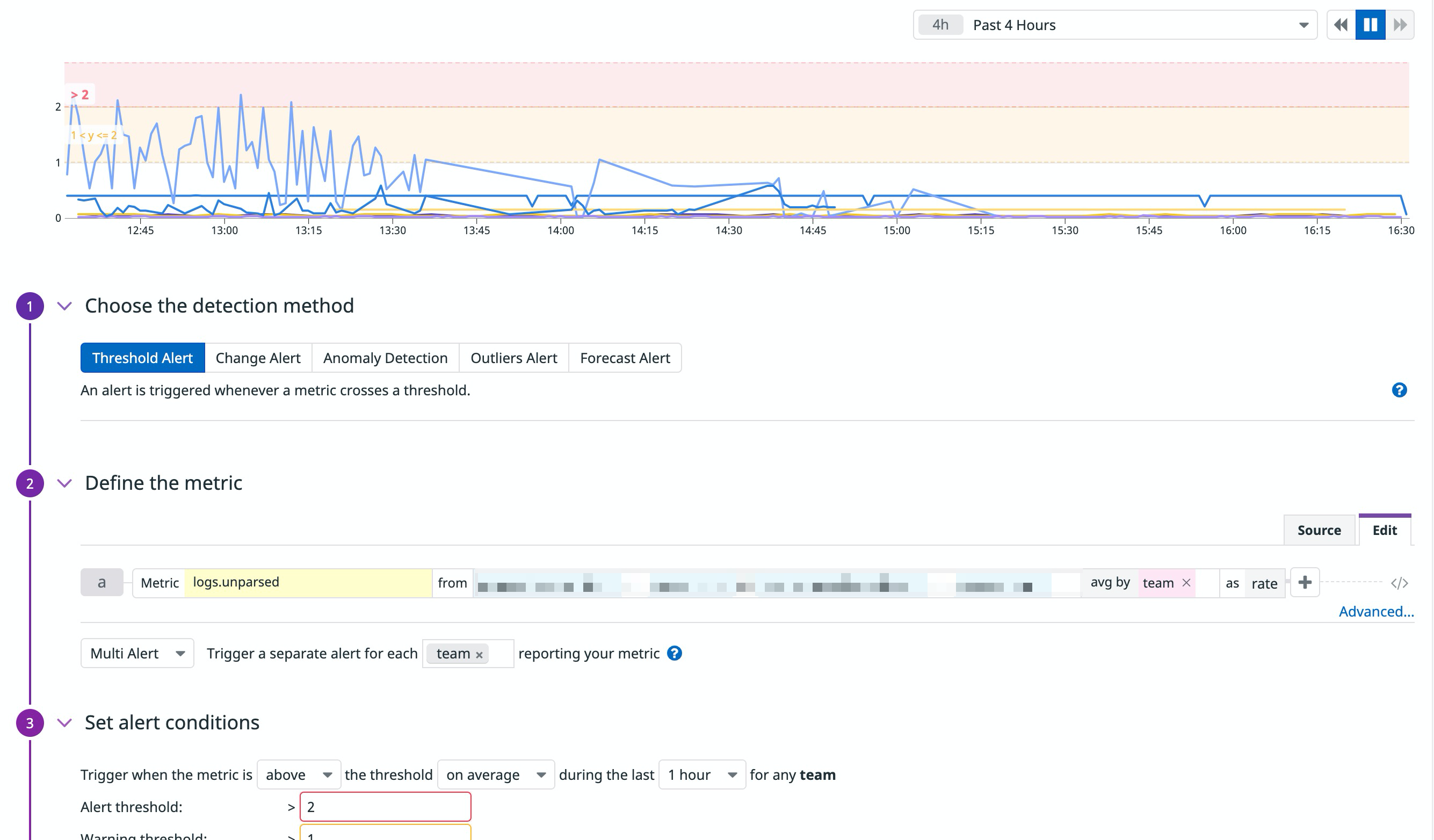- Essentials
- Getting Started
- Datadog
- Datadog Site
- DevSecOps
- Serverless for AWS Lambda
- Agent
- Integrations
- Containers
- Dashboards
- Monitors
- Logs
- APM Tracing
- Profiler
- Tags
- API
- Service Catalog
- Session Replay
- Continuous Testing
- Synthetic Monitoring
- Incident Management
- Database Monitoring
- Cloud Security Management
- Cloud SIEM
- Application Security Management
- Workflow Automation
- CI Visibility
- Test Visibility
- Test Impact Analysis
- Code Analysis
- Learning Center
- Support
- Glossary
- Standard Attributes
- Guides
- Agent
- Integrations
- OpenTelemetry
- Developers
- Authorization
- DogStatsD
- Custom Checks
- Integrations
- Create an Agent-based Integration
- Create an API Integration
- Create a Log Pipeline
- Integration Assets Reference
- Build a Marketplace Offering
- Create a Tile
- Create an Integration Dashboard
- Create a Recommended Monitor
- Create a Cloud SIEM Detection Rule
- OAuth for Integrations
- Install Agent Integration Developer Tool
- Service Checks
- IDE Plugins
- Community
- Guides
- Administrator's Guide
- API
- Datadog Mobile App
- CoScreen
- Cloudcraft
- In The App
- Dashboards
- Notebooks
- DDSQL Editor
- Sheets
- Monitors and Alerting
- Infrastructure
- Metrics
- Watchdog
- Bits AI
- Service Catalog
- API Catalog
- Error Tracking
- Service Management
- Infrastructure
- Application Performance
- APM
- Continuous Profiler
- Database Monitoring
- Data Streams Monitoring
- Data Jobs Monitoring
- Digital Experience
- Real User Monitoring
- Product Analytics
- Synthetic Testing and Monitoring
- Continuous Testing
- Software Delivery
- CI Visibility
- CD Visibility
- Test Optimization
- Code Analysis
- Quality Gates
- DORA Metrics
- Security
- Security Overview
- Cloud SIEM
- Cloud Security Management
- Application Security Management
- AI Observability
- Log Management
- Observability Pipelines
- Log Management
- Administration
Monitor and query for unparsed logs
Overview
Parsed logs are central to be able to use Datadog Log Management to its full capacity, for queries, monitors, aggregations or automatic enrichments such as sensitive data scanner. When you are scaling your volume of logs it can be challenging to identify and fix logs patterns that are not parsed by your pipelines.
To identify and control the volume of unparsed logs in your organization:
- Detect unparsed logs
- Query for unparsed logs
- Create a metric to track for unparsed logs
- Monitor the volume of unparsed logs
Detect unparsed logs
To determine if a specific log has been parsed by your pipelines, open the log and check the Event Attributes panel. If the log is unparsed, instead of showing attributes extracted from your log, the panel shows a message saying that no attributes were extracted:
You can start parsing and unparsed log by creating custom pipelines or using a log integration as the source of the log to take advantage of the automatic pipeline setup.
Query for unparsed logs
If you have many logs, making one-by-one checking unviable, you can instead query for unparsed logs by using the filter datadog.pipelines:false in the Log Explorer:
This filter returns all indexed logs without custom attributes after the pipeline processing. Pattern aggregation shows an aggregated view of the common patterns in the unparsed logs, which can kickstart your creation of custom pipelines.
Create a metric to track for unparsed logs
Querying for unparsed logs lets you select the unparsed indexed logs. It’s also a good practice to ensure that even the logs that you do not index are parsed, so that the content of your archives are structured.
To create a metric for unparsed logs, create a custom metric using the datadog.pipelines:false query:
As for any log-based metric, you can add dimensions in the group by field. The example above shows grouping by service and team. You should group by the dimensions that you are using to define the ownership of a log.
Monitor the volume of unparsed logs
To ensure that the logs parsing in your organization is kept under control, apply a quota for the unparsed logs volume. This approach is close to what is proposed with daily quotas for indexes.
To monitor the volume of unparsed logs:
- Create a metric monitor.
- Use the previously created
logs.unparsedmetric. - Define the quota per
team. - Ensure that the alert conditions fit when you want to be alerted.
Further Reading
Additional helpful documentation, links, and articles:




